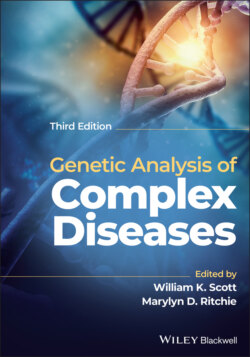Читать книгу Genetic Analysis of Complex Disease - Группа авторов - Страница 10
Оглавление
Foreword
This book grew from our four‐day NIH‐sponsored course, which, for 20 years, was focused on providing an overview and guide to the design and execution of human genetic mapping studies for these common (and genetically complex) diseases, melding the genomic technology with the statistical rigor needed to apply and interpret the results. When we developed the concept for the first edition of this book in 1996, the Human Genome Project was just reaching full speed, combining continual breakthroughs in DNA gene mapping and sequencing technology with emerging applications to human disease to shed the first light on the organization of the human genome and the variations that cause disease. The first applications of the Human Genome Project data were to find the location, and ultimately the causative mutations, for rare Mendelian inherited diseases. It was dogma then that the genetic architecture of common diseases was beyond our reach, based on the naïve belief that Mendelian disease represented how genetic variation impacted disease. However, we soon demonstrated, with the discovery that multiple apolipoprotein E (APOE) alleles had differing and strong effects on the risk of Alzheimer disease, that these technologies and approaches could be adapted to illuminate the genetic underpinnings of common diseases.
The rapid advances in both DNA technology and statistical methodology demanded that a significant update to the book was needed, with the second edition of the book in 2006. By this point the blood and protein markers of the 1970s had been surpassed by the restriction fragment length polymorphisms (RFLPs) of the 1980s, the microsatellite repeats of the 1990s, and the single nucleotide polymorphisms (SNPs, of which RFLPs are a subset) for the past 20 years. Naturally, the analyses of these data also advanced from early mainframe applications of genetic linkage analysis in small numbers of families, to PC‐powered analyses of thousands of cases and controls for association.
In the past 15 years since that second edition, increasingly dense SNP arrays and whole exome or whole genome sequencing have created new horizons for dissecting complex diseases. In addition, the explosion of other “omics” data, particularly gene expression data, provide biological context for the discovered DNA variations, adding biological interpretation as a critical element of genetic studies.
With all these advances, it became apparent that a new edition of this book was warranted, and new and fresh perspectives were needed. Thus, we turned over the editing of this new edition to two of our brilliant younger colleagues, who have been active in both developing and applying methods at the forefront of genetics and genomics. While the inclusion of genome‐wide association studies, integration of genomic data, and data mining are new, the breadth of the book in describing the overall process of designing and executing successful projects remains.
Finally, we fondly acknowledge the continuing impact of our mentor, Dr. P. Michael Conneally, who inspired both of us to inquire, question, investigate, and solve, the often difficult, constantly emerging human genetic puzzles. He encouraged us to help educate researchers, physician‐scientists, and physicians in the complex nature of genetic studies. He wrote the forward for the first two editions, and although he passed away in 2017, his legacy remains in our work and the work of our trainees and collaborators.
We are immensely grateful to Bill and Marylyn for taking on this important task and developing this excellent third edition of the book.
Jonathan L. Haines, PhD
Margaret A. Pericak‐Vance, PhD
